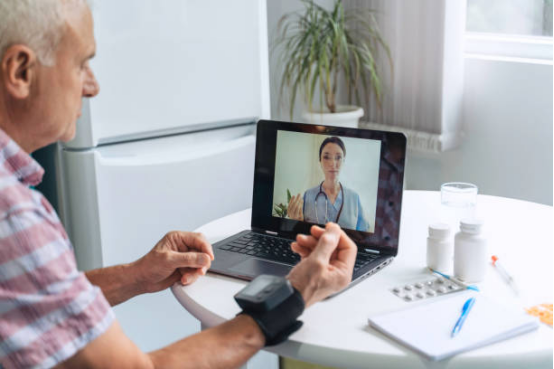Remote Patient Monitoring in 2024: A Revolution in Healthcare Delivery
In 2024, Remote Patient Monitoring (RPM) has continued to evolve and revolutionize how healthcare is delivered. With advancements in wearable technology, mobile apps, and telemedicine, RPM has significantly enhanced the quality of care provided to patients, particularly those with chronic conditions. This article explores the impact of RPM, its advantages, challenges, and what the future holds for this transformative technology in healthcare.
In 2024, Remote Patient Monitoring (RPM) has continued to evolve and revolutionize how healthcare is delivered. With advancements in wearable technology, mobile apps, and telemedicine, RPM has significantly enhanced the quality of care provided to patients, particularly those with chronic conditions. This article explores the impact of RPM, its advantages, challenges, and what the future holds for this transformative technology in healthcare.

What is Remote Patient Monitoring?
Remote Patient Monitoring refers to the process of using technology to track and monitor a patient’s health data outside of a traditional healthcare setting. RPM typically involves wearable devices and mobile apps that track vital signs such as heart rate, temperature, blood pressure, and glucose levels. The data collected is then transmitted to healthcare providers for analysis, allowing for real-time interventions when necessary. RPM plays a crucial role in chronic disease management, ensuring that patients receive continuous care without the need for frequent visits to the hospital or clinic.
RPM has shown great potential in managing conditions such as heart disease, diabetes, and hypertension. By constantly collecting and transmitting health data, RPM provides healthcare professionals with valuable insights, which can lead to more effective treatments and a reduction in hospital readmissions.
The Role of Telemedicine in RPM
The combination of telemedicine and RPM has been a game-changer in healthcare delivery. Telemedicine allows for virtual consultations, where healthcare providers can review data received from RPM devices and discuss treatment options with patients remotely. This integration ensures that patients receive timely feedback and adjustments to their care plans, even without needing to visit a healthcare facility.
For patients in rural or underserved areas, telemedicine and RPM together offer a convenient solution to accessing specialized care without long travel distances. This combination enhances patient convenience, improves continuity of care, and ensures better overall health outcomes.
Key Benefits of Remote Patient Monitoring
RPM offers multiple benefits, revolutionizing healthcare delivery for both patients and providers:
1. Continuous Care:
RPM ensures continuous monitoring of patients’ health, which allows healthcare providers to intervene immediately when any changes are detected. This is particularly valuable for patients with chronic conditions who need constant surveillance.
2. Improved Patient Engagement:
RPM puts patients in control of their health by providing them with data on their condition. This increased engagement helps patients adhere to treatment plans and make healthier lifestyle choices. Engaged patients are more likely to follow up with their care and report concerns before they become emergencies.
3. Cost Reduction:
RPM reduces healthcare costs by eliminating the need for frequent in-person visits. For patients, it saves time and travel expenses. For providers, it reduces overhead costs, as the need for physical space and staff time is minimized. These cost savings help make healthcare more affordable for both parties.
4. Personalized Treatment:
By continuously collecting health data, RPM enables healthcare providers to deliver highly personalized care. Providers can adjust treatment plans in real time based on patients' current health conditions, ensuring that interventions are both timely and relevant.
Challenges in Adopting RPM
While RPM offers numerous benefits, its adoption faces several challenges:
1. Digital Divide:
Many patients, especially those in rural areas, older adults, or those with lower income, may lack access to the technology necessary for RPM. Without access to smartphones, wearables, or a stable internet connection, these patients are at risk of being excluded from the benefits of RPM.
2. Data Privacy Concerns:
The transfer of sensitive health information through digital platforms raises concerns about data security. Ensuring that patient data is protected from cyberattacks and unauthorized access is essential for maintaining trust in RPM systems.
3. Technology Adoption:
Some patients may find it difficult to adopt and regularly use RPM devices. Education and support are crucial to ensure patients understand how to use these tools effectively and safely.
4. Integration with Healthcare Systems:
Successful RPM relies on seamless integration with existing healthcare systems. Healthcare providers must have access to the data in real-time, and it must be incorporated into their workflows for it to be useful in making clinical decisions.
The Future of RPM
The future of RPM looks promising, with continued advancements in AI and machine learning allowing for smarter and more personalized care. Predictive analytics could help identify potential health risks before they occur, enabling even more proactive interventions. Additionally, as regulatory barriers ease, and insurance reimbursement for remote care increases, RPM will become a more accessible tool for both patients and providers.
RPM is also likely to become more intuitive, with devices becoming easier to use and offering more comprehensive health monitoring. The integration of new health metrics into RPM systems, such as mental health monitoring, will further expand the scope of care provided remotely.
Conclusion
Remote Patient Monitoring has already proven to be a transformative technology in healthcare, offering numerous benefits such as cost reduction, improved patient outcomes, and enhanced convenience. However, challenges related to technology access, data security, and patient engagement must be addressed to fully unlock its potential. As technology continues to evolve and healthcare systems adapt, RPM will become an integral part of routine healthcare delivery, paving the way for a more efficient, inclusive, and patient-centered healthcare system.